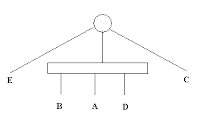MO640 - Multiple-choice question
To test for the C1P on a connected component of the strict overlap graph, we need to keep a linear order (called Path in the figure below) of twin classes, and update the structure with each new set added.Suppose that a certain number of sets have been processed, with the C1P being satisfied so far, and arriving at the structure shown below.

When adding a new set S, the current classes can be classified into three categories:
- empty (no elements in common with S),
- full (contained in S), or
- partial (some, but not all, ements contained in S).
- ... the C1P would be destroyed because there is a twin class of new elements but not a suitable extremity in the path to place it.
- ... the C1P would still hold true.
- ... the C1P would be destroyed because some class is partial and there is no empty neighbour or free extremity to place the subclass disjoint from S.
- ... the C1P would be destroyed because the updated classes contained in S do not form a consecutive block.
- None of the above.
Original idea by: Celso A. W. Santos
























